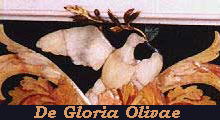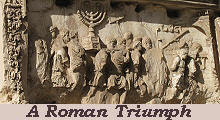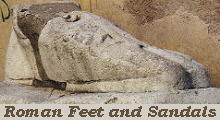

What's New!
Detailed Sitemap
All images © by Roberto Piperno, owner of the domain. Write to romapip@quipo.it. Text edited by Rosamie Moore.
|
Change and tradition in the papal transition to 
Part Two
Foreword
This page contains minor remarks and curiosities related to the events and ceremonies
associated with the appointment of the successor to Pope John Paul II. For a page covering aspects
of the death of a pope click here.
The Conclave
Morto un papa, se ne fa un altro is the Roman way of saying that once a
pope passes away, the attention immediately focuses on the appointment of his successor, in other words that life goes on. During each of the nine days of mourning a mass is held in St. Peter's with the attendance
of all the cardinals: a different cardinal pronounces the homily and although the speech is centered on the virtues of the deceased pope it also
hints at the desired characteristics of his successors. All the cardinals participate
in this initial part of the process leading to the election of the new pope, but only the cardinals below
80 years of age actually take part in the conclave. This age barrier was introduced very recently by Pope Paul VI and
confirmed by Pope John Paul II, notwithstanding the adverse opinion of many members of the church and theologists.
Coats of arms of the pope and of the titular cardinal
in S. Maria della Pace; other references to the titular cardinal in other churches
Cardine is the Italian word for pivot, the short shaft on which a joint rotates and cardinale was the adjective designating the deacons, priests and bishops
who supported the activity of the ancient Roman churches, called tituli. Over time it became used as a noun designating those who had a right to
participate in the election of the pope, who in the early centuries of Christianity was very often chosen outside the Collegio Cardinalizio, as the cardinals as a group are called.
In the structure of the Roman diocese there are six suburbicarian bishops (the
bishops of Porto, Albano, Frascati,
Velletri, Palestrina and Sabina a region to the north of Rome, so there are only six
cardinal bishops). In 1586 Pope Sixtus V established that the total number of cardinals should not exceed 70 with the
following division: 14 cardinal deacons, 50 cardinal priests and the six cardinal bishops mentioned above. In 1958 this limit was abolished, but the reference to the churches of Rome was retained and this explains why most of the churches show at the entrance two coats of arms: that of the reigning pontiff
and that of the titular cardinal.
Some coats of arms of cardinals (April 2005)
Most of the coats of arms of the cardinals were designed when they were appointed bishops and therefore
show religious symbols: in a few cases the motto (the sentence accompanying the coat of arms) is not written in
Latin, the official language of the Roman Catholic Church. Several cardinals have the same motto Ut (Omnes) Unum Sint (in order that they all become one ...) , the initial
words of an encyclical letter (the formal papal letters dealing with the most important topics) issued by Pope John Paul II.
Extra omnes (all out) with these words the master of ceremonies will announce the
start of the conclave by asking all those who do not have the right to attend it to leave the Sistine Chapel: nearly one third of the
cardinals will have to leave because they are over 80. Those left are (in 2005) 117, but some of them will not participate because of poor health.
As a matter of fact the 2005 papal election process could hardly warrant to be called a conclave. This word
means "with keys" and it refers to the procedures introduced in the XIIIth century to protect the
cardinals from external influences: according to these rules the cardinals were confined in a limited place and could not be approached by anyone. The conclaves held in the Vatican
made use of the vast Sistine Chapel which was partitioned by timber panels into a number of tiny cells where the cardinals had to live until they elected the new pope.
Pope John Paul II felt that these arrangements were no longer compatible with modern life and built a residence Ospizio di Santa Marta
where the cardinals involved in the conclave find a Spartan, but nonetheless more comfortable accommodation. In addition the cardinals, according to new rules, can move within the Vatican, the
Sistine Chapel remaining their meeting place.
The old rules, with all their severe restrictions, did not actually protect the cardinals from undue pressure. On September 1, 1914 (WWI had just started) an Austrian cardinal read to his astonished colleagues,
on the first day of the conclave called to nominate the successor to Pope Pius X, a letter written by the Austrian Emperor Francis Joseph, by which he advocated an ancient right
reserved to the emperors (of the Sacred Roman Empire) to put their veto on the proposed election of a certain cardinal. Thus Cardinal Rampolla del Tindaro, thought to be philo-French, was excluded from the competition.
This was the last open interference by a government in a conclave. Many tend to group the cardinals according to their nationality (Italians, South Americans, Africans, and so on) believing that they may act in the conclave as a political party in a parliament.
Assuming this comparison had some grounds the "political parties" into which the cardinals are divided have more to do with their views
on the key challenges the Roman Catholic Church is facing. In the conclave of 1963 the cardinals were split on the great changes introduced by the
deceased Pope John XXIII and to some extent this division was still present in the following conclaves.
A certain career path mixing both curial and pastoral responsibilities
may increase the chances of a certain cardinal: the holding of a nunciature (Church embassies) is also taken into account,
although on some occasions not with a favourable eye, because the nuncio had too close links with a dictator.
Another possible grouping of the cardinals has to do with their responsibilities: very often those
holding important positions in the central government of the church, the Curia (a name which comes from the oldest political institutions of Ancient Rome) have different views from those who are involved in a more pastoral activity.
Because
the appointment of cardinals is reserved to the pope who in turn is elected by the cardinals (who are also called Princes of the Church), from a political viewpoint the government of the Church can be classified as a co-optation process, with some points in common with that existing
in the Most Serene Republic of Venice where for nearly a thousand years a doge was elected for life by an aristocratic body.
Chi entra papa, esce cardinale (who enters the conclave as the most likely pope, comes out as a cardinal) is the
popular Roman say meaning that in the end the Holy Spirit guides the cardinals in their decisions and all guesses turn wrong.
The coat of arms of the reigning pope (John Paul II) in the Vatican Gardens seen from St. Peter's dome in 2001
While the cardinals are busy casting their ballots, the Main Gardener of the Vatican carefully reviews their coats of arms to be
prepared to modify the flower-bed behind St. Peter's (and visible from the dome) where a new green coat of arms will soon replace that of the deceased pope.
The New Pope
Fumata nera (black smoke signal) is ordinarily used in Italian to mean a negative decision. The sentence derives from the traditional way
the cardinals let the outside world know that a ballot did not lead to the election of the new pope. By converse fumata bianca (white smoke signal) means a positive decision.
The ballot-papers after being opened and counted are burnt with such additives to make the smoke black or white and those waiting in St. Peter's square learn
from its colour whether they will soon see the new pope or not.
Appearance of the pope from St. Peter's loggia - Pope's bearers (XIXth century prints)
Nuntio vobis magnum gaudium (I announce you a great joy) with these words the senior cardinal announces the new pope and he adds the name of the elected cardinal and his new name.
In the past the appearance of the new pope was marked by great pomp which was greatly reduced by Pope John XXIII to the dismay of the so called
"Black nobility", the Roman nobility of papal appointment, whose members did not accept the 1870 annexation of
Rome and thus put on their palaces and dresses (black) mourning marks.
They had several roles in the papal ceremonies, in particular they were very proud of bearing the papal chair.
A shop selling ecclesiastical outfits and a very special one
The area near S. Maria sopra Minerva is known for the many shops selling
suits for the clergy and objects for religious ceremonies. The shop window of Sartoria (tailor's) Gammarelli however does not display suits for priests and abbots, friars and nuns,
but just a white zucchetto, the white skull-cap reserved to the pope. Gammarelli provides the papal outfit
for the first appearance of the new pope. It is prepared in three sizes and it is adjusted at the last minute by a few pins.
The New Bishop of Rome
The most important ceremony marking the election of the new pope was the procession which accompanied him from the Vatican to
S. Giovanni in Laterano, the ancient site of the Papal see. The procession was called possessio as the pope by crossing the whole city
took possession of Rome.
1724 print by Bernard Picart (1673-1733) showing Pope Benedict XIII's "possessio"
Many painters and engravers have left a visual memory of this procession. To show the procession in its entirety they
used a bustrophedic pattern: this unusual word applies to languages which are written from left to right and backwards and it derives
from the way a field is ploughed.
The pope on the white horse
The pope reached S. Giovanni in Laterano riding a white mule or horse or on an elaborate litter. The procession moved from the Vatican to Castel Sant'Angelo,
crossed the Tiber at Ponte Sant'Angelo and moved towards S. Andrea della Valle, Campidoglio, Colosseo, S. Clemente to eventually reach Piazza di S. Giovanni in Laterano (the only specific location
shown in the print).
The cardinal bishops and the band
All the cardinals followed the pope, first the cardinal bishops, then the cardinal priests and last the cardinal deacons.
Trumpets and drums announced the arrival
of the procession. Representatives of the guilds waited for the arrival of the pope and in various forms
showed him their submission and devotion. The Jews showed him a Bible and the pope in turn recognized the sanctity of the book, but blamed them for
their false interpretation of it.
Triumphal arches in 1724 and 1721
Each guild or "nation" (community of foreigners living in Rome) was responsible for the decoration of a section of the itinerary. The municipality of Rome used to erect an ephemeral triumphal arch in Piazza del Campidoglio and on some
occasions the Florentine community did the same near S. Giovanni dei Fiorentini (they made a special effort in 1605 to celebrate the election of
Pope
Leo XI, the Florentine Cardinal Alessandro de' Medici: the arch was particularly rich, but it did not bring good luck to the pope who on that same day got sick and passed away ten days later). The most magnificent
arches were erected in the Forum in front of the Orti Farnesiani, by the Duke of Parma (a Farnese): the first one for the possessio of Pope Innocent X in 1644. They were designed by some of the best
architects: Girolamo Rainaldi (Innocent X - 1644); Carlo Rainaldi (Clement IX - 1667; Clement X - 1670; Alexander VIII - 1689);
Carlo Fontana (Innocent XII - 1692; Clement XI - 1701); Ferdinando Fuga (Benedict XIV - 1740).
The image used as a background for this page shows the coat of arms of Pope John Paul II.

SEE THESE OTHER EXHIBITIONS (for a full list see my Detailed Index)
  
|